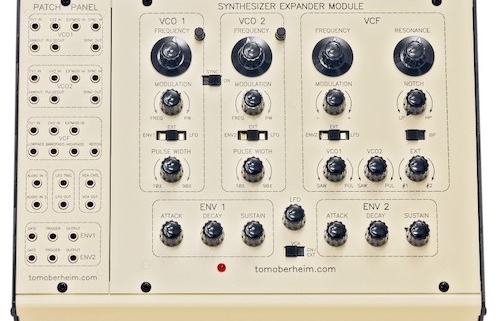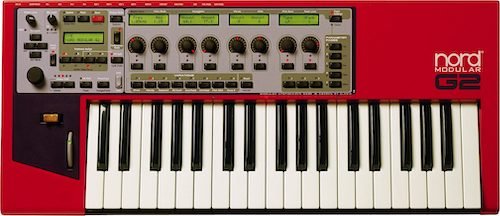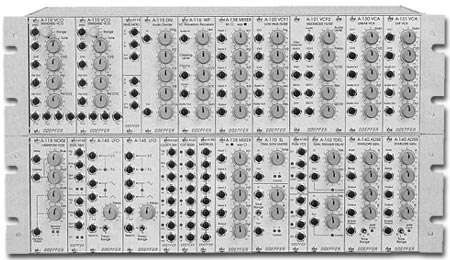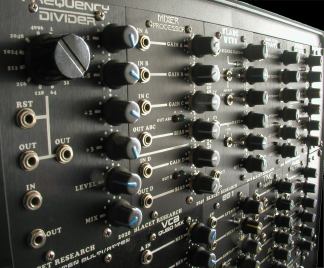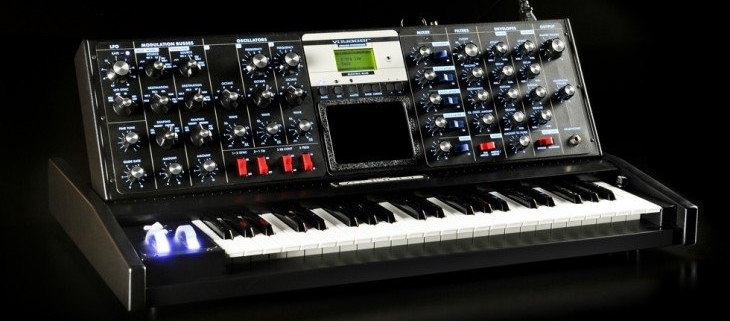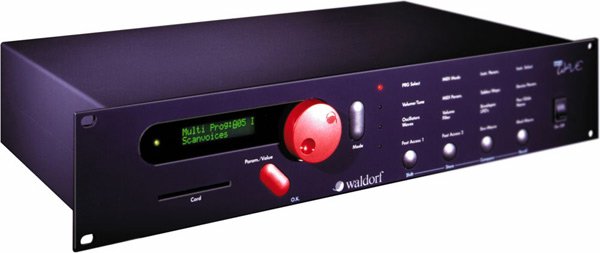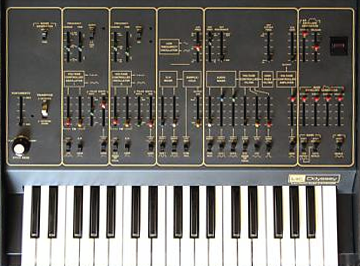This one is easy to waste hours at a time with. A really hands-on synth, and patchpoints always makes things more fun. Plays nicely with the modular.
I always thought combined D/R-stages in the envelopes are a bit weird. True for this one as well. On the other hand, that partly contributes to what it sounds like, I suppose.
Wow. I can’t say Wow enough. The original NM’s younger as well as bigger brother, having everything the original one lacked (MIDI modules, decent keyboard). This simply is an incredible piece of machinery. Functionally it builds on the original, only makes it better. I can’t understand why they abandoned this concept, nothing out there comes even close to the flexibility it provides. OK, I actually kind of do understand: Modular synths are not for everybody, but this is such a wonderful concept that even if it is inherently modular, as a user you don’t actually even need to know that. The brilliance of this piece is so out there in its own category I just can’t find the words, so I’ll just shut up now.
I kind of stalked this machine. I found it in a music store in Helsinki, high up on a shelf as close to the ceiling as possible, and I came to check it out every week or so when I was in town. Bit by bit it had been moved downwards, and once it had been on subshoulder level for a couple of weeks I just had to buy it, because of course I had to. Turned out it was pretty much the last one in Europe, if not the entire world. The shop guys had found it in a box in the basement, in a pile of empty boxes, and brought it up from the dead, so to speak. I was quite lucky there…
The more, the merrier. The Wiard modules seem to be quite expensive, but I got two FracRack-format cheapies, which turned out to have an enormous impact on the realtime tweakability of the modular’s parameters: a nice little joystick and a joystick axis generator. The joystick axis generator is a kind of Modulation Matrix Lite: it takes two input CV’s, and spits them out in various ratios through a number of outputs. Up, down, left, right, and in-between, plus middle and the complement of middle. Patch in a joystick or two LFO’s, connect all the outputs to appropriate inputs, and listen to the sound change drastically and becoming really alive. The JAG comes highly recommended!
My main Modular of choice. I sold my Doepfer (and a spitload of other gear) to finance this, and I am not one bit sorry that I did. The feel is very reliable, the sound is massive, and it simply looks like a modular should look. A shame I could not actually a/b the sound of this and Doepfer, but this sounds really wonderful. My plan is to build a flexible modular, which will include interesting modules from several modular manufacturers, and in which the dotcom will be the core. I have had loads of fun with this already, and this is again one of those investments that have a potential to be for life.
At first I wanted to get a custom walnut cabinet, but it turned out that my modular Muurame bookshelf is a perfect fit for rack gear. And I have a lot of Muurame modules…
Butt-ugly or not, the amount of available interesting modules is quite overwhelming, so I really saw no reason not to include Doepfer in my rig. As with Blacet, the idea is to complement the main modular. The first modules I got were two theremin modules, which should prove fun both to me and my daughter. Doepfer’s got a huge amount of filters and other sounds processing modules, so I think it will grow out of proportion and that I will feel quite good about it, all things considered.
The first “next” manufacturer to be added alongside the dotcom modules. Blacet modules come in kits or assembled, and without hesitation I went for the assembled ones. I don’t quite trust myself behind the soldering iron, I might end up with something not-so-safe. Blacet uses the FracRack form factor, and the same annoyingly small jacks as Doepfer, but I figured I shouldn’t be too picky about these things. Blacet have some fun modules, and there really is no reason not to get some, as they integrate quite nicely into what is now becoming a Frankensynth.
A Moog. Pronounced “Mogue”. This is a heavy piece of work, and it just oozes quality. It sounds exactly the way you would think a Moog should sound. Solid as a rock and absolutely no complaints about its sonic properties. There’s one interesting design flaw, though: when the electrical cord is attached to it and the panel is lowered to its lowest position, the entire weight of the panel ends up resting on the cord. How could that ever get a green light? Oh well, nobody’s perfect.
I actually put this one for sale after Judgment Day, but nobody wanted it. Go figure. So I still have it. I would probably like to go simpler, meaning I would not mind trading it for a re-issue of the Model D. Drop me a line if you’re interested.
OK, then. Time to go seriously analog. My plan was very simple: to build a modular synthesizer one module at a time, and spend serious quality time with each new module in order to truly learn it. I ordered an empty 6U case, and oscillator and an lfo and sat down and waited. While I waited, I happened to place the winning bid on an entire full 6U system from eBay. So much for going slowly.
Doepfer has a truly excellent setup of modules and they are very reasonably priced. Still, before my modular grew out of proportion, I decided to go for another brand, the Synthesizers.com modular. So I sold the Doepfer and ordered a dotcom instead.
Main reasons for not keeping Doepfer: small plugs feel a bit flimsy, small modules are a bit unergonomic, and it isn’t black 🙂
My Doepferlessness didn’t last for long, though…
I bought this by mistake. I got it dirt cheap from eBay; I just placed a very low bid and ended up getting it. Never really used it; kept it for a few months, then sold it to help finance a dotcom modular. Er, I sold a bunch of other stuff as well; this one didn’t quite cover the dotcom price…
Now we’re talking Synth History. I grew up listening to this machine, without even knowing it, as it was used by all those bands that shaped my taste in music. Playing around with this for the first time was an almost religious experience. In my Quest for Simplicity, this one takes the cake so far. What you see is what you get, plain and simple. Nothing is hidden, so just go for it. In that sense, this would have been the perfect first synth, but I don’t mind getting it now. This particular unit is one of the original Odyssey’s with a black face and the 24 dB filters. Or so I was told, I have yet to verify it. I would have to open it up, remove all the slider caps and dissassemble it in order to get a peek at the filter chip, and I just can’t be bothered now. It’s a great machine for weird metallic sounds.
The duophonice feature is quite interesting; when holding a key and pressing another, the other key “borrows” the second oscillator, and you can get quite nice effects that way. Also, getting it to Finland was an adventure in itself. An official Thanks to m@ & Gert who made it possible

